Using only binoculars, we explore a host of inky dust clouds, the dark nebulae that smudge the Milky Way on late summer nights.
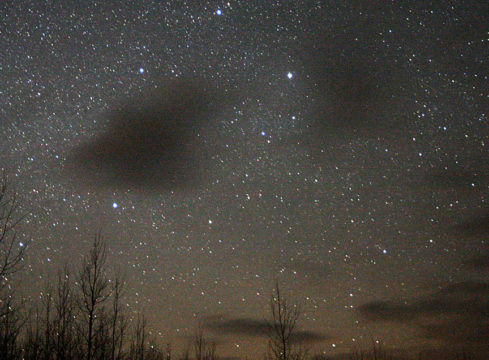
Bob King
Lots of seasoned amateurs recommend binoculars over a telescope as an easy and inexpensive way for a beginning skywatcher to learn more about the denizens of the night sky. Once you're familiar with the brighter constellations, binoculars can take you to the next level and reveal the brighter deep-sky objects, numerous asteroids, all the planets, a potpourri of double stars ... and dark nebulae!
I've looked at lots of dark nebulae in telescopes, but many are easily visible in binoculars, too. So I thought I'd take my own advice and make for the countryside with only a pair of binoculars and a star atlas instead of a 75 pounds of telescope.
Dark nebulae might be called anti-deep-sky objects as most don't look any different from a proverbial "hole in the sky," more absence than presence. So it seemed to generations of skywatchers until about a century ago, when American astronomer E. E. Barnard and others came to realize the holes were really massive clouds of dark dust blocking the light of more distant suns. The same way passing clouds appear in black silhouette against the glow of the Milky Way, cosmic dust clouds, fashioned by galactic tides into every imaginable shape, shadow the stars that lie beyond.
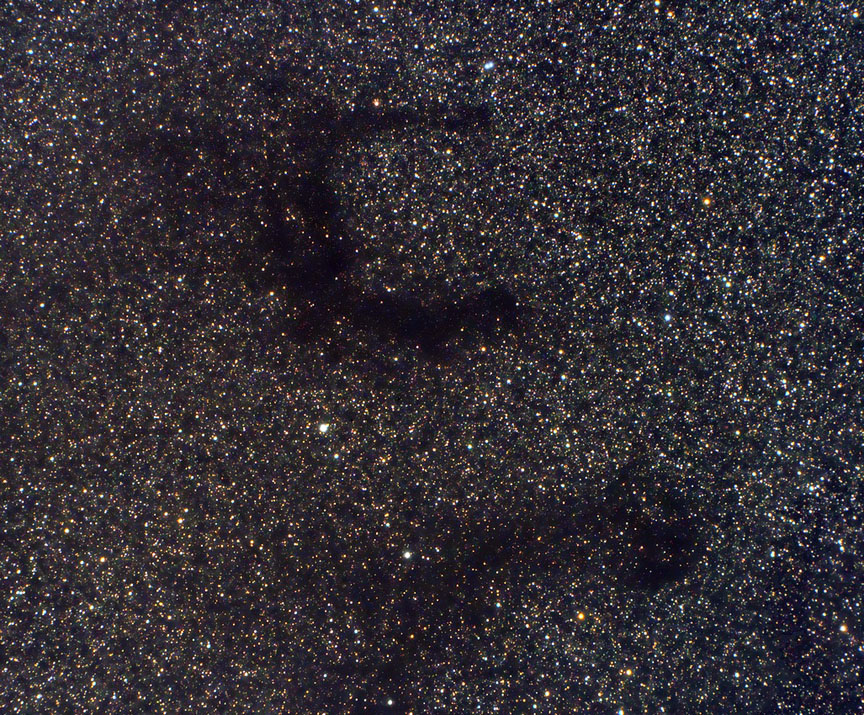
Hunter Wilson
Lots of dark nebulae are big enough and opaque enough to see in ordinary binoculars. The wide-angle variety are best, since they provide an ample field of view against which to see the dark forms. I use 10×50 Minoltas that combine enough magnification, a large 6.5° field of view, and comfortable eye relief. The vast majority of dark nebulae snake through the plane of the galaxy, so the best place to find them is in the band of the Milky Way from Sagittarius–Scorpius north through Cepheus. Here the dense, starry backdrop makes an ideal backdrop for these inky clouds to strut their stuff.
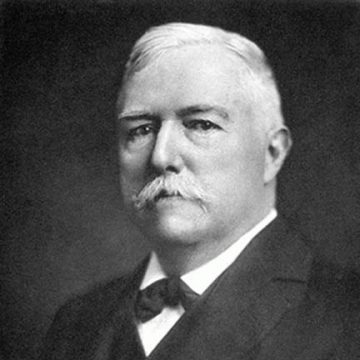
Public Domain
Dark nebulae were cataloged by Barnard in his Catalog of Dark Markings in the Sky and later by American astronomer Beverly Lynds in the Lynds' Catalog of Dark Nebulae based on the National Geographic - Palomar Observatory Sky Survey. Barnard objects are labeled with a capital "B" and the Lynds' nebulae by LDN or simply "L." The nebulae are further described by their size and opacity, a measure of how dense (dark) they appear against the stellar background. The scale runs from 1 to 6 in order of increasing opacity.
Generally, the higher the opacity, the greater the contrast and the easier a nebula is to see. In the descriptions below, I've abbreviated opacity to "op" and listed the size of each nebula in arcminutes.
I had to restrict this observing guide to nebulae north of the Sagittarius–Ophiuchus region because these regions are now low in the sky from my latitude (47°N) and have been compromised in recent weeks by a nightly veil of smoke from forest fires in California and British Columbia. We'll go there another time. For this round, let's leave the horizon haze behind and head north, starting with Aquila.
Aquila
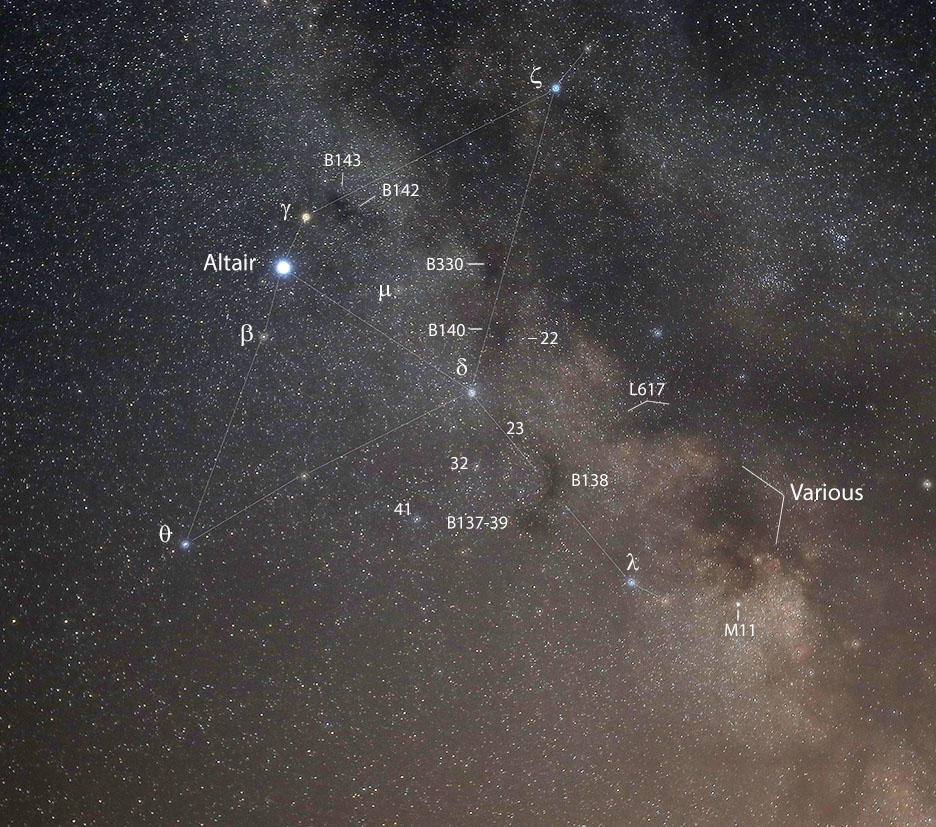
Bob King
No question that B143 (60′ × 60′, op. 6) and B142 (40′ × 40′, op. 5) are two of the finest dark nebulae in any instrument. I could even glimpse B143 as a small, dark hole with the naked eye under dark skies. The larger and more obvious of the two, its dark prongs pair up with neighboring B142 to scrawl out the letter the "E" in homage to Edward Emerson Barnard.
If you now slide your glass 6° southwest of this pair you'll find a second, more widely-spaced pair of dark patches, B330 (30′ × 30′, op. 4) and B140 (60′ × 60′, op. 3). While not nearly as inky as the previous duo, they're still obvious, particularly B140, as it's framed on all sides by several 7th-magnitude stars.
Midway between Delta (δ) and Lambda (λ) Aquilae we arrive at one my favorites, B138 (180′ × 10′, op. 2) and its extensions, B137 (12′, op. 3) and B139 (10′ × 2′, op. 5). This 3°-long, mostly vacant arc has a curious, smoky-gray mottled texture. I like the shape which resembled a feathery quill dipped in an inkwell.
Six degrees to the west of the quill, look for a thick, horizontal gap in the stars about 2° long and elongated east–west. This is LDN 617 (~180′ × 15′, op. 5), which resides along the eastern edge of the prominent dark lane that splits the Milky Way into two in this region of the sky. It's vague, but after a few tries with averted vision, you'll have it. The tail of Aquila, where it borders with Scutum, is pocked with many dark nebulae that are difficult to distinguish from one another, but together they create a star-poor area about 4.5° across.
Cygnus
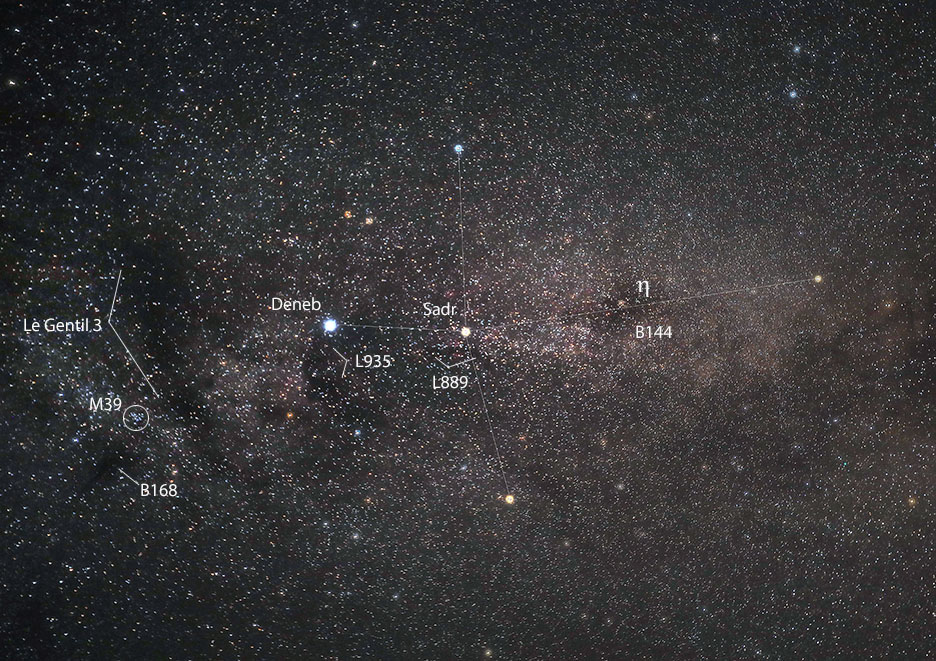
Bob King
Cygnus is so rich with chunks of the Milky Way that where the stars thin out, you'll swear you're seeing one dark nebula after another. It's easy to fall prey to these galactic hijinks, so be sure to use the map above, an atlas like Uranometria 2000.0 or an online planetarium-style program like Stellarium.
Let's start big with B144 (6° × 3°, op. 1), which in spite of its weak opacity is a delightful, field-filling sight in the 10×50s. I see lots of mottling with areas of higher and lower opacity centered on the 4th-magnitude star Eta (η) Cygni. B144 sits squarely in the spectacular Cygnus Star Cloud, making it one of the most seductive regions to sweep in a low-power glass. From here, head north to Gamma (γ) Cygni (Sadr) for an impressive view of the narrow, north-south-elongated nebula L889 (1.5° × ~15′, op. 5). I think you'll like how it snakes up along the east side of the star.
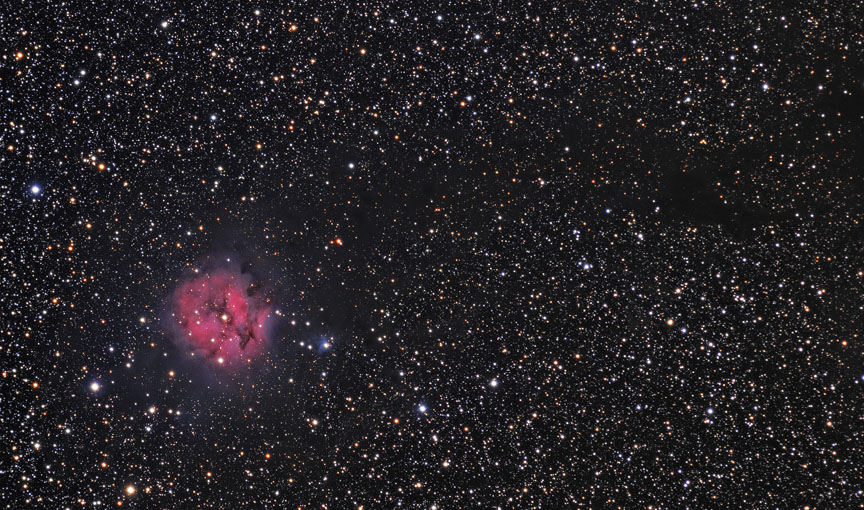
Hunter Wilson
L935 (90′ × 20′, op. 4) is a striking zigzag of black lightning just east of Deneb separating the North American Nebula from the Pelican Nebula, both of which I can faintly see in my binoculars. If you next look 8° north of Deneb, you'll stumble across the Funnel Nebula, also called Le Gentil 3, a huge gash at least 10° long that bisects the Milky Way. Put down your binoculars and soak in the naked-eye view. Yes, dark nebulae can be this amazing.
We finish up Cygnus with B168 (100′ × 10′, op. 4) a narrow, dark streak almost 2° long that cuts like a dagger through the rich stellar backdrop. Easy to see, the nebula lies just 1.5° west of the attractive binocular cluster, M39.
Cepheus
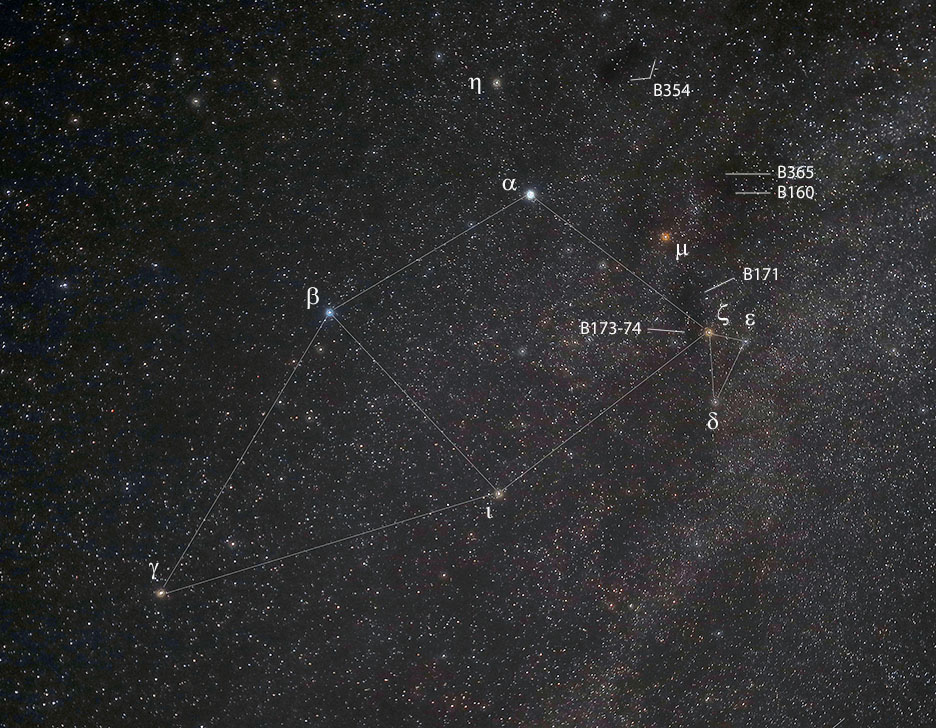
Bob King
After the studded star fields of Cygnus, the Milky Way thins in Cepheus. I found several dark nebulae within its confines, but they were generally of low opacity and required averted vision to confirm. The easiest was a trio of three overlapping nebulae that includes B171 (op.5), B169, and B170. Combined, they make a 1°-wide dark patch ~1° west of Zeta (ζ) Cephei. Smaller B173 (4′, op. 6) and B174 (19′, op. 6) extend just north of the complex.
Likewise, I can make out the lower opacity neighboring blots, B365 (22′ × 3′, op. 4) and B160 (30′ × 15′, op. 4) 2.5° south of the pretty red supergiant star Mu (μ) Cephei. If you look 6° southwest of Alpha (α) Cephei using averted vision, you'll also discern B354 (60′ × ~25′, op. 2), a vague, relatively starless vacuity that extends north-south.
As you explore the dusty recesses of the galaxy, consider that every dark nebula had a bright past as dust blown from the atmospheres of red giant stars and set loose in supernovae explosions. In time, gravity will gather and re-forge that material into new star clusters. Dark clouds will give way to sunshine again.
 7
7








Comments
astromaster
August 15, 2018 at 1:23 pm
Hi Bob: Too bad you are so far north. Many of the easiest Dark Nebulae are in the south toward the center of the Milky Way! However, one easy one in your Aquila pic that you left out is LDN ID#141 that is just to the upper right of zeta Aquila at the edge of your pic and actually in Hercules. Dr. Lynds particularly listed "ID" Dark Nebulae in her list of Dark Nebulae so that observers could understand that there were groups of her individual Dark Nebulae that seemed to make up larger and easily observable objects like LDN ID#141 which includes such individual Lynds Dark Nebulae as LDN 666 etc. There are many other LDN ID#s in your other pics and in other parts of the sky that are covered in my new book.
Check out my new 630 page book, Bright and Dark Nebulae: An Observers Guide to Understanding the Clouds of the Milky Way Galaxy, CreateSpace, 2017 via https://www.createspace.com/7355429
You must be logged in to post a comment.
Bob KingPost Author
August 17, 2018 at 5:48 pm
Hi Astro,
I only included a selection of some of the more prominent ones — indeed, there are many more! Thanks for the book link 🙂
You must be logged in to post a comment.
Kerbal9
August 16, 2018 at 2:28 am
Thanks, very interesting!
You must be logged in to post a comment.
Bob KingPost Author
August 17, 2018 at 5:50 pm
You're welcome, Kerbal!
You must be logged in to post a comment.
SNH
August 17, 2018 at 5:58 pm
Really glad you wrote another article about dark nebulae, Bob. Since you "published" a link to my 250+ Catalog, Astromaster and I have been getting to know each other and he has been helping me learn to better identify dark nebulae on Dr. Lynds list. Here is a link
(https://www.cloudynights.com/topic/626832-help-identifying-dark-nebulae-in-northern-cygnus/)
to the Cloudy Nights page where I heavily labeled an image of the Cygnus Milky Way with DkN I can see in binoculars and naked-eye. There are just so many in northern Cygnus it's hard to identify them all!
Thanks,
Scott
You must be logged in to post a comment.
Anthony Barreiro
August 17, 2018 at 6:50 pm
Thanks very much, Bob. I'll save this list for when I'm under dark skies. One thing that perhaps goes without saying: dark nebulae are completely invisible through light pollution. My rule of thumb: I'll look for dark nebulae if I can easily see the milky way. Otherwise there's not enough contrast.
You must be logged in to post a comment.
anniecmox
August 9, 2020 at 2:47 pm
thanks, Bob King
There are many types of binoculars. However, the binoculars used for hunting are a little different.
Because the binoculars that are made for hunting have a special design. These have special aspects that are quite beneficial for hunting.
You must be logged in to post a comment.
You must be logged in to post a comment.